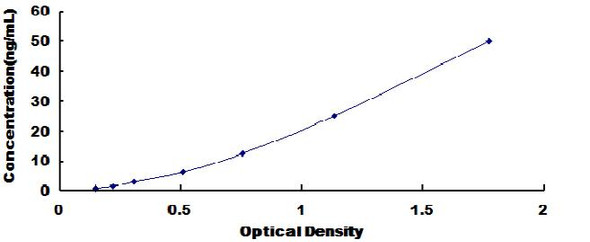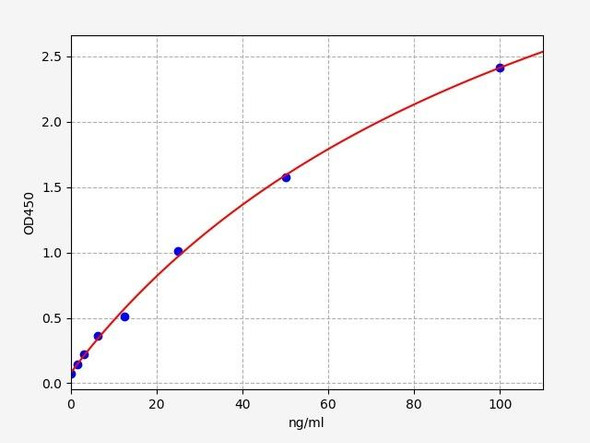Human Myogenin (MYOG) ELISA Kit (HUEB1110)
- SKU:
- HUEB1110
- Product Type:
- ELISA Kit
- Size:
- 96 Assays
- Uniprot:
- P15173
- Range:
- 0.312-20 ng/mL
- ELISA Type:
- Sandwich
- Synonyms:
- MYOG, Myogenin, BHLHC3, MYF4, bHLHc3Myogenic factor-4, myogenin, Class C basic helix-loop-helix protein 3, myf-4, Myf-4, MYF4myogenin, Myogenic factor 4, MYOGENIN, myogenin, myogenic factor 4
- Reactivity:
- Human
Description
Human Myogenin (MYOG) ELISA Kit
The Human Myogenin (MYOG) ELISA Kit is specifically designed for the precise quantification of myogenin levels in human serum, plasma, and cell culture supernatants. This kit offers exceptional sensitivity and specificity, guaranteeing consistent and accurate results for various research purposes.Myogenin is a key regulatory protein that plays a vital role in muscle development and differentiation.
Its expression is crucial for the formation of muscle cells, making it a valuable biomarker for studying muscle-related diseases and conditions. The Human Myogenin ELISA Kit provides researchers with a reliable tool for investigating the role of myogenin in muscle physiology and pathology, offering insights into potential therapeutic targets and strategies.
| Product Name: | Human Myogenin (MYOG) ELISA Kit |
| SKU: | HUEB1110 |
| Size: | 96T |
| Target: | Human Myogenin (MYOG) |
| Synonyms: | Class C basic helix-loop-helix protein 3, Myogenic factor 4, bHLHc3, Myf-4, BHLHC3, MYF4 |
| Assay Type: | Sandwich |
| Detection Method: | ELISA |
| Reactivity: | Human |
| Detection Range: | 0.312-20ng/mL |
| Sensitivity: | 0.12ng/mL |
| Intra CV: | 3.8% | ||||||||||||||||||||
| Inter CV: | 5.9% | ||||||||||||||||||||
| Linearity: |
| ||||||||||||||||||||
| Recovery: |
| ||||||||||||||||||||
| Function: | Acts as a transcriptional activator that promotes transcription of muscle-specific target genes and plays a role in muscle differentiation, cell cycle exit and muscle atrophy. Essential for the development of functional embryonic skeletal fiber muscle differentiation. However is dispensable for postnatal skeletal muscle growth; phosphorylation by CAMK2G inhibits its transcriptional activity in respons to muscle activity. Required for the recruitment of the FACT complex to muscle-specific promoter regions, thus promoting gene expression initiation. During terminal myoblast differentiation, plays a role as a strong activator of transcription at loci with an open chromatin structure previously initiated by MYOD1. Together with MYF5 and MYOD1, co-occupies muscle-specific gene promoter core regions during myogenesis. Cooperates also with myocyte-specific enhancer factor MEF2D and BRG1-dependent recruitment of SWI/SNF chromatin-remodeling enzymes to alter chromatin structure at myogenic late gene promoters. Facilitates cell cycle exit during terminal muscle differentiation through the up-regulation of miR-20a expression, which in turn represses genes involved in cell cycle progression. Binds to the E-box containing (E1) promoter region of the miR-20a gene. Plays also a role in preventing reversal of muscle cell differentiation. Contributes to the atrophy-related gene expression in adult denervated muscles. Induces fibroblasts to differentiate into myoblasts. |
| Uniprot: | P15173 |
| Sample Type: | Serum, plasma, tissue homogenates, cell culture supernates and other biological fluids |
| Specificity: | Natural and recombinant human Myogenin |
| Sub Unit: | Homodimer and heterodimer with E12; heterodimerization enhances MYOG DNA-binding and transcriptional activities. Interacts with SMARCA4/BRG1/BAF190A. Interacts (via C-terminal region) with SSRP1 and SUPT16H; the interaction is indicative of an interaction with the FACT complex (By similarity). Interacts with CSRP3. |
| Research Area: | Metabolism |
| Subcellular Location: | Nucleus Recruited to late myogenic gene promoter regulatory sequences with SMARCA4/BRG1/BAF190A and SWI/SNF chromatin-remodeling enzymes to promote chromatin-remodeling and transcription initiation in developing embryos. |
| Storage: | Please see kit components below for exact storage details |
| Note: | For research use only |
| UniProt Protein Function: | myogenin: Involved in muscle differentiation (myogenic factor). Induces fibroblasts to differentiate into myoblasts. Probable sequence specific DNA-binding protein. |
| UniProt Protein Details: | Protein type:DNA-binding; Transcription factor Chromosomal Location of Human Ortholog: 1q32.1 Cellular Component: nucleoplasm; nucleus; transcription factor complex Molecular Function:chromatin DNA binding; protein binding; protein heterodimerization activity; RNA polymerase II transcription factor activity, enhancer binding; sequence-specific DNA binding; transcription factor activity Biological Process: mRNA transcription from RNA polymerase II promoter; muscle cell fate commitment; negative regulation of cell proliferation; positive regulation of muscle atrophy; positive regulation of muscle cell differentiation; positive regulation of myoblast differentiation; positive regulation of skeletal muscle fiber development; positive regulation of transcription from RNA polymerase II promoter; regulation of satellite cell proliferation; response to denervation involved in regulation of muscle adaptation; response to electrical stimulus involved in regulation of muscle adaptation; response to muscle activity involved in regulation of muscle adaptation; skeletal muscle development; striated muscle atrophy |
| NCBI Summary: | Myogenin is a muscle-specific transcription factor that can induce myogenesis in a variety of cell types in tissue culture. It is a member of a large family of proteins related by sequence homology, the helix-loop-helix (HLH) proteins. It is essential for the development of functional skeletal muscle. [provided by RefSeq, Jul 2008] |
| UniProt Code: | P15173 |
| NCBI GenInfo Identifier: | 127625 |
| NCBI Gene ID: | 4656 |
| NCBI Accession: | P15173.2 |
| UniProt Secondary Accession: | P15173,Q53XW6, |
| UniProt Related Accession: | P15173 |
| Molecular Weight: | 25,037 Da |
| NCBI Full Name: | Myogenin |
| NCBI Synonym Full Names: | myogenin |
| NCBI Official Symbol: | MYOG |
| NCBI Official Synonym Symbols: | MYF4; myf-4; bHLHc3 |
| NCBI Protein Information: | myogenin |
| UniProt Protein Name: | Myogenin |
| UniProt Synonym Protein Names: | Class C basic helix-loop-helix protein 3; bHLHc3; Myogenic factor 4; Myf-4 |
| Protein Family: | Myosin |
| UniProt Gene Name: | MYOG |
| Component | Quantity (96 Assays) | Storage |
| ELISA Microplate (Dismountable) | 8×12 strips | -20°C |
| Lyophilized Standard | 2 | -20°C |
| Sample Diluent | 20ml | -20°C |
| Assay Diluent A | 10mL | -20°C |
| Assay Diluent B | 10mL | -20°C |
| Detection Reagent A | 120µL | -20°C |
| Detection Reagent B | 120µL | -20°C |
| Wash Buffer | 30mL | 4°C |
| Substrate | 10mL | 4°C |
| Stop Solution | 10mL | 4°C |
| Plate Sealer | 5 | - |
Other materials and equipment required:
- Microplate reader with 450 nm wavelength filter
- Multichannel Pipette, Pipette, microcentrifuge tubes and disposable pipette tips
- Incubator
- Deionized or distilled water
- Absorbent paper
- Buffer resevoir
*Note: The below protocol is a sample protocol. Protocols are specific to each batch/lot. For the correct instructions please follow the protocol included in your kit.
Allow all reagents to reach room temperature (Please do not dissolve the reagents at 37°C directly). All the reagents should be mixed thoroughly by gently swirling before pipetting. Avoid foaming. Keep appropriate numbers of strips for 1 experiment and remove extra strips from microtiter plate. Removed strips should be resealed and stored at -20°C until the kits expiry date. Prepare all reagents, working standards and samples as directed in the previous sections. Please predict the concentration before assaying. If values for these are not within the range of the standard curve, users must determine the optimal sample dilutions for their experiments. We recommend running all samples in duplicate.
| Step | |
| 1. | Add Sample: Add 100µL of Standard, Blank, or Sample per well. The blank well is added with Sample diluent. Solutions are added to the bottom of micro ELISA plate well, avoid inside wall touching and foaming as possible. Mix it gently. Cover the plate with sealer we provided. Incubate for 120 minutes at 37°C. |
| 2. | Remove the liquid from each well, don't wash. Add 100µL of Detection Reagent A working solution to each well. Cover with the Plate sealer. Gently tap the plate to ensure thorough mixing. Incubate for 1 hour at 37°C. Note: if Detection Reagent A appears cloudy warm to room temperature until solution is uniform. |
| 3. | Aspirate each well and wash, repeating the process three times. Wash by filling each well with Wash Buffer (approximately 400µL) (a squirt bottle, multi-channel pipette,manifold dispenser or automated washer are needed). Complete removal of liquid at each step is essential. After the last wash, completely remove remaining Wash Buffer by aspirating or decanting. Invert the plate and pat it against thick clean absorbent paper. |
| 4. | Add 100µL of Detection Reagent B working solution to each well. Cover with the Plate sealer. Incubate for 60 minutes at 37°C. |
| 5. | Repeat the wash process for five times as conducted in step 3. |
| 6. | Add 90µL of Substrate Solution to each well. Cover with a new Plate sealer and incubate for 10-20 minutes at 37°C. Protect the plate from light. The reaction time can be shortened or extended according to the actual color change, but this should not exceed more than 30 minutes. When apparent gradient appears in standard wells, user should terminatethe reaction. |
| 7. | Add 50µL of Stop Solution to each well. If color change does not appear uniform, gently tap the plate to ensure thorough mixing. |
| 8. | Determine the optical density (OD value) of each well at once, using a micro-plate reader set to 450 nm. User should open the micro-plate reader in advance, preheat the instrument, and set the testing parameters. |
| 9. | After experiment, store all reagents according to the specified storage temperature respectively until their expiry. |
When carrying out an ELISA assay it is important to prepare your samples in order to achieve the best possible results. Below we have a list of procedures for the preparation of samples for different sample types.
| Sample Type | Protocol |
| Serum | If using serum separator tubes, allow samples to clot for 30 minutes at room temperature. Centrifuge for 10 minutes at 1,000x g. Collect the serum fraction and assay promptly or aliquot and store the samples at -80°C. Avoid multiple freeze-thaw cycles. If serum separator tubes are not being used, allow samples to clot overnight at 2-8°C. Centrifuge for 10 minutes at 1,000x g. Remove serum and assay promptly or aliquot and store the samples at -80°C. Avoid multiple freeze-thaw cycles. |
| Plasma | Collect plasma using EDTA or heparin as an anticoagulant. Centrifuge samples at 4°C for 15 mins at 1000 × g within 30 mins of collection. Collect the plasma fraction and assay promptly or aliquot and store the samples at -80°C. Avoid multiple freeze-thaw cycles. Note: Over haemolysed samples are not suitable for use with this kit. |
| Urine & Cerebrospinal Fluid | Collect the urine (mid-stream) in a sterile container, centrifuge for 20 mins at 2000-3000 rpm. Remove supernatant and assay immediately. If any precipitation is detected, repeat the centrifugation step. A similar protocol can be used for cerebrospinal fluid. |
| Cell culture supernatant | Collect the cell culture media by pipette, followed by centrifugation at 4°C for 20 mins at 1500 rpm. Collect the clear supernatant and assay immediately. |
| Cell lysates | Solubilize cells in lysis buffer and allow to sit on ice for 30 minutes. Centrifuge tubes at 14,000 x g for 5 minutes to remove insoluble material. Aliquot the supernatant into a new tube and discard the remaining whole cell extract. Quantify total protein concentration using a total protein assay. Assay immediately or aliquot and store at ≤ -20 °C. |
| Tissue homogenates | The preparation of tissue homogenates will vary depending upon tissue type. Rinse tissue with 1X PBS to remove excess blood & homogenize in 20ml of 1X PBS (including protease inhibitors) and store overnight at ≤ -20°C. Two freeze-thaw cycles are required to break the cell membranes. To further disrupt the cell membranes you can sonicate the samples. Centrifuge homogenates for 5 mins at 5000xg. Remove the supernatant and assay immediately or aliquot and store at -20°C or -80°C. |
| Tissue lysates | Rinse tissue with PBS, cut into 1-2 mm pieces, and homogenize with a tissue homogenizer in PBS. Add an equal volume of RIPA buffer containing protease inhibitors and lyse tissues at room temperature for 30 minutes with gentle agitation. Centrifuge to remove debris. Quantify total protein concentration using a total protein assay. Assay immediately or aliquot and store at ≤ -20 °C. |
| Breast Milk | Collect milk samples and centrifuge at 10,000 x g for 60 min at 4°C. Aliquot the supernatant and assay. For long term use, store samples at -80°C. Minimize freeze/thaw cycles. |










